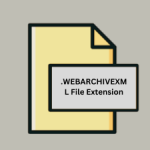.SVC File Extension

What is an SVC file?
The .SVC file extension stands for Service File and is primarily associated with Windows Communication Foundation (WCF) web services.
These files are crucial in creating and managing web services within the .NET framework. WCF, a part of Microsoft’s .NET framework, facilitates the development of distributed applications by providing a unified programming model for building service-oriented applications.
More Information.
Before the advent of WCF, developers used different technologies for various types of web services, including ASP.NET Web Services (ASMX) and Windows Workflow Foundation (WF).
Each of these technologies had its own method of defining and interacting with services, which could lead to fragmentation and complexity in managing service-oriented architectures.
The introduction of WCF was aimed at unifying these technologies into a single framework, providing a more consistent approach to developing web services.
The .SVC file plays a critical role in this unification by serving as the endpoint configuration file for WCF services. Its primary purpose is to define how a WCF service is hosted and accessed, and it acts as a bridge between the service implementation and the client that consumes it.
Origin Of This File.
The .SVC file extension originated with the release of Windows Communication Foundation (WCF) as part of the .NET Framework 3.0.
Introduced by Microsoft in 2006, WCF was designed to simplify the creation of service-oriented applications by integrating various communication technologies under a single framework.
The .SVC file was created to define and configure these services, allowing developers to expose functionality over the web.
File Structure Technical Specification.
A .SVC file is a text file that contains XML-based configuration information and service implementation details.
While the file itself does not contain executable code, it references the service implementation and specifies how the WCF service should be hosted and accessed. Here’s a breakdown of its structure:
- Service Implementation Reference: The .SVC file includes a reference to the actual service implementation class, typically written in C# or VB.NET. This is where the business logic of the service resides.
- Service Endpoint Configuration: The file specifies the endpoint addresses, bindings, and contracts that define how the service communicates with clients. This includes details such as the URL, the protocol (HTTP, HTTPS, TCP, etc.), and the data encoding format.
- Service Metadata: The .SVC file may also include metadata settings that provide information about the service’s capabilities and how it should be described to clients.
The technical specifications of a .SVC file revolve around its role in the WCF framework. It is not directly executable but is used by the WCF runtime to manage service requests. The actual service logic is implemented in separate code files that are referenced by the .svc file.
How to Convert the File?
Converting a .SVC file itself is not typically necessary or straightforward since it is a configuration file rather than data or content.
If you need to convert the service implementation or its functionality, consider the following approaches:
- Service Migration: If migrating from WCF to another service framework (e.g., ASP.NET Core Web API), you will need to rewrite the service implementation and reconfigure endpoints accordingly. This involves updating the code and configuration to match the new framework’s requirements.
- Code Transformation: The code-behind file associated with the .SVC file (e.g.,
MyService.svc.cs) can be refactored or ported to different frameworks, depending on the target technology. - Data Transformation: If the service is interacting with data, ensure that data formats and schemas are compatible with the new framework or technology.
Advantages And Disadvantages.
Advantages:
- Unified Framework: WCF and .SVC files provide a unified approach to building web services, integrating multiple communication technologies and protocols into a single framework.
- Flexibility: WCF allows developers to expose services over different protocols, such as HTTP, TCP, and MSMQ, making it versatile for various scenarios.
- Security: WCF offers comprehensive security features, including authentication, authorization, and encryption, which can be configured through the .SVC file and associated configuration files.
- Extensibility: The .SVC file and WCF framework support extensibility, allowing developers to customize service behaviors and add new functionality.
Disadvantages:
- Complexity: Configuring WCF services can be complex, especially for developers unfamiliar with its extensive feature set and configuration options.
- Performance Overhead: WCF services may introduce performance overhead compared to simpler web service technologies due to the additional features and flexibility they offer.
- Learning Curve: The learning curve for WCF and .SVC files can be steep for developers new to the framework or service-oriented architecture.
How to Open SVC?
Open In Windows
- .SVC files can be opened with any text editor such as Notepad or advanced editors like Visual Studio Code or Visual Studio. These tools provide syntax highlighting and code editing features that are beneficial for working with XML files and WCF configurations.
Open In Linux
- On Linux, .SVC files can be opened with text editors such as Gedit, Nano, or Vim. Visual Studio Code is also available for Linux and provides a powerful environment for editing configuration files.
Open In MAC
- On macOS, you can use text editors like TextEdit, Sublime Text, or Visual Studio Code to open and edit .SVC files. Visual Studio Code is especially useful for its cross-platform support and rich feature set.













